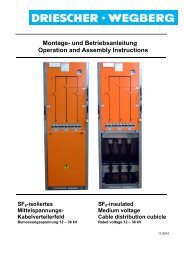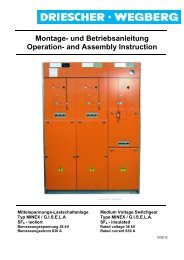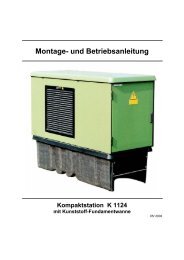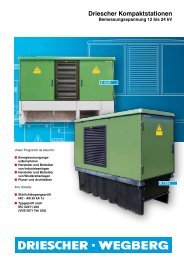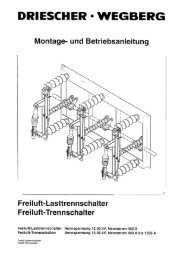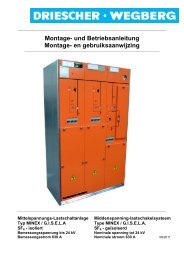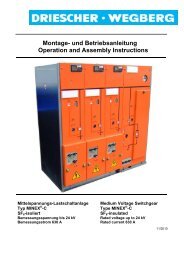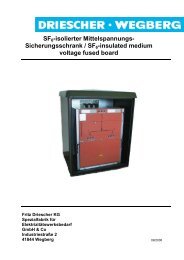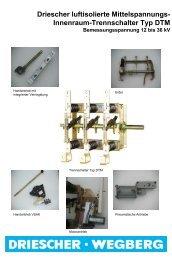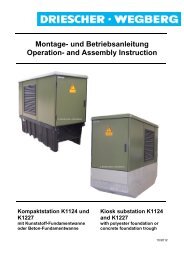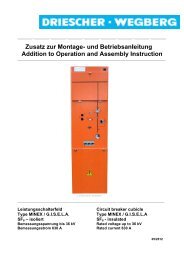Montage- und Betriebsanleitung Operation and Assembly Instructions
Montage- und Betriebsanleitung Operation and Assembly Instructions
Montage- und Betriebsanleitung Operation and Assembly Instructions
Sie wollen auch ein ePaper? Erhöhen Sie die Reichweite Ihrer Titel.
YUMPU macht aus Druck-PDFs automatisch weboptimierte ePaper, die Google liebt.
DRIESCHER • WEGBERG<br />
Kabelprüfung<br />
Kabelprüfung bei angeschlossenem Kabel<br />
ist eine besondere Beanspruchung der<br />
Trennstrecke.<br />
Unzulässige Überspannungen infolge von<br />
reflektierenden Überspannungswellen vermeiden.<br />
Überspannungsableiter oder entsprechende<br />
Schutzbeschaltungen vorsehen.<br />
Gehen Sie behutsam <strong>und</strong> aufmerksam vor!<br />
Benutzen Sie nur die zum angeschlossenen<br />
Steckertyp gehörigen Kabelprüfelemente.<br />
Vorgehensweise<br />
Vorbereitende Maßnahmen<br />
⇒ Zu prüfenden Abgang gemäß dieser Anleitung<br />
freischalten, erden <strong>und</strong> kurzschließen.<br />
⇒ Sicherstellen, dass der Abgang in der Gegenstation<br />
ebenfalls freigeschaltet ist.<br />
⇒ Einschubplatte einschieben<br />
⇒ Tür öffnen<br />
⇒ Kabelprüfelemente des Endverschlussherstellers<br />
gemäß <strong>Betriebsanleitung</strong> montieren.<br />
Prüfen<br />
⇒ Erdung aufheben<br />
⇒ Prüfung durchführen. Prüfgleichspannung<br />
anlegen.<br />
⇒ Prüfgleichspannung aufheben<br />
Nach Abschluss der Prüfung<br />
⇒ Abgang erden<br />
⇒ Kabelprüfelemente demontieren.<br />
⇒ Tür schließen<br />
⇒ Einschubplatte entfernen<br />
Kabelabgang ist nun wieder für eine Inbetriebnahme<br />
vorbereitet.<br />
32 LDTM<br />
Cable testing<br />
Procedure<br />
A cable test with connected cables means<br />
special stress to the isolating distance.<br />
Avoid inadmissible overvoltages due to reflective<br />
overvoltage waves. Provide lightning<br />
arresters or corresponding suppressor circuits.<br />
Be careful <strong>and</strong> pay attention!<br />
Only use cable testing elements belonging to<br />
the connected plug type.<br />
Preparing actions<br />
⇒ Isolate, earth <strong>and</strong> short-circuit the outgoing<br />
circuit that shall be tested.<br />
⇒ Make sure that the outgoing circuit in the remote<br />
station is also isolated.<br />
⇒ Insert the insulating protective plate<br />
⇒ Open the door<br />
⇒ Install the cable testing elements from the cable<br />
terminal manufacturer according to the installation<br />
manual.<br />
Testing<br />
⇒ Clear the earthing<br />
⇒ Execute the test. Apply the D.C. test voltage.<br />
⇒ Clear the D.C. test voltage.<br />
After conclusion of the test<br />
⇒ Earth the outgoing circuit<br />
⇒ Disassemble the cable testing elements<br />
⇒ Close the door<br />
⇒ Remove the insulating protective plate<br />
Now the outgoing cable is ready again for setting to<br />
work.



